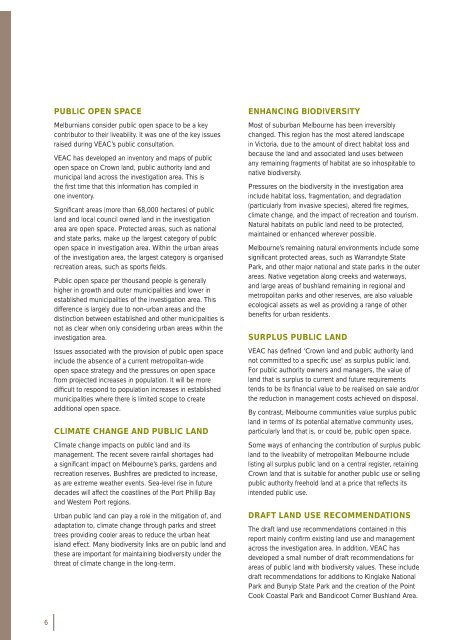Metropolitan Melbourne Investigation Discussion Paper - Victorian ...
Metropolitan Melbourne Investigation Discussion Paper - Victorian ...
Metropolitan Melbourne Investigation Discussion Paper - Victorian ...
Create successful ePaper yourself
Turn your PDF publications into a flip-book with our unique Google optimized e-Paper software.
PUBLIC OPEN SPACE<br />
Melburnians consider public open space to be a key<br />
contributor to their liveability. It was one of the key issues<br />
raised during VEAC’s public consultation.<br />
VEAC has developed an inventory and maps of public<br />
open space on Crown land, public authority land and<br />
municipal land across the investigation area. This is<br />
the fi rst time that this information has compiled in<br />
one inventory.<br />
Signifi cant areas (more than 68,000 hectares) of public<br />
land and local council owned land in the investigation<br />
area are open space. Protected areas, such as national<br />
and state parks, make up the largest category of public<br />
open space in investigation area. Within the urban areas<br />
of the investigation area, the largest category is organised<br />
recreation areas, such as sports fi elds.<br />
Public open space per thousand people is generally<br />
higher in growth and outer municipalities and lower in<br />
established municipalities of the investigation area. This<br />
difference is largely due to non-urban areas and the<br />
distinction between established and other municipalities is<br />
not as clear when only considering urban areas within the<br />
investigation area.<br />
Issues associated with the provision of public open space<br />
include the absence of a current metropolitan-wide<br />
open space strategy and the pressures on open space<br />
from projected increases in population. It will be more<br />
diffi cult to respond to population increases in established<br />
municipalities where there is limited scope to create<br />
additional open space.<br />
CLIMATE CHANGE AND PUBLIC LAND<br />
Climate change impacts on public land and its<br />
management. The recent severe rainfall shortages had<br />
a signifi cant impact on <strong>Melbourne</strong>’s parks, gardens and<br />
recreation reserves. Bushfi res are predicted to increase,<br />
as are extreme weather events. Sea-level rise in future<br />
decades will affect the coastlines of the Port Phillip Bay<br />
and Western Port regions.<br />
Urban public land can play a role in the mitigation of, and<br />
adaptation to, climate change through parks and street<br />
trees providing cooler areas to reduce the urban heat<br />
island effect. Many biodiversity links are on public land and<br />
these are important for maintaining biodiversity under the<br />
threat of climate change in the long-term.<br />
ENHANCING BIODIVERSITY<br />
Most of suburban <strong>Melbourne</strong> has been irreversibly<br />
changed. This region has the most altered landscape<br />
in Victoria, due to the amount of direct habitat loss and<br />
because the land and associated land uses between<br />
any remaining fragments of habitat are so inhospitable to<br />
native biodiversity.<br />
Pressures on the biodiversity in the investigation area<br />
include habitat loss, fragmentation, and degradation<br />
(particularly from invasive species), altered fi re regimes,<br />
climate change, and the impact of recreation and tourism.<br />
Natural habitats on public land need to be protected,<br />
maintained or enhanced wherever possible.<br />
<strong>Melbourne</strong>’s remaining natural environments include some<br />
signifi cant protected areas, such as Warrandyte State<br />
Park, and other major national and state parks in the outer<br />
areas. Native vegetation along creeks and waterways,<br />
and large areas of bushland remaining in regional and<br />
metropolitan parks and other reserves, are also valuable<br />
ecological assets as well as providing a range of other<br />
benefi ts for urban residents.<br />
SURPLUS PUBLIC LAND<br />
VEAC has defi ned ‘Crown land and public authority land<br />
not committed to a specifi c use’ as surplus public land.<br />
For public authority owners and managers, the value of<br />
land that is surplus to current and future requirements<br />
tends to be its fi nancial value to be realised on sale and/or<br />
the reduction in management costs achieved on disposal.<br />
By contrast, <strong>Melbourne</strong> communities value surplus public<br />
land in terms of its potential alternative community uses,<br />
particularly land that is, or could be, public open space.<br />
Some ways of enhancing the contribution of surplus public<br />
land to the liveability of metropolitan <strong>Melbourne</strong> include<br />
listing all surplus public land on a central register, retaining<br />
Crown land that is suitable for another public use or selling<br />
public authority freehold land at a price that refl ects its<br />
intended public use.<br />
DRAFT LAND USE RECOMMENDATIONS<br />
The draft land use recommendations contained in this<br />
report mainly confi rm existing land use and management<br />
across the investigation area. In addition, VEAC has<br />
developed a small number of draft recommendations for<br />
areas of public land with biodiversity values. These include<br />
draft recommendations for additions to Kinglake National<br />
Park and Bunyip State Park and the creation of the Point<br />
Cook Coastal Park and Bandicoot Corner Bushland Area.<br />
6
















